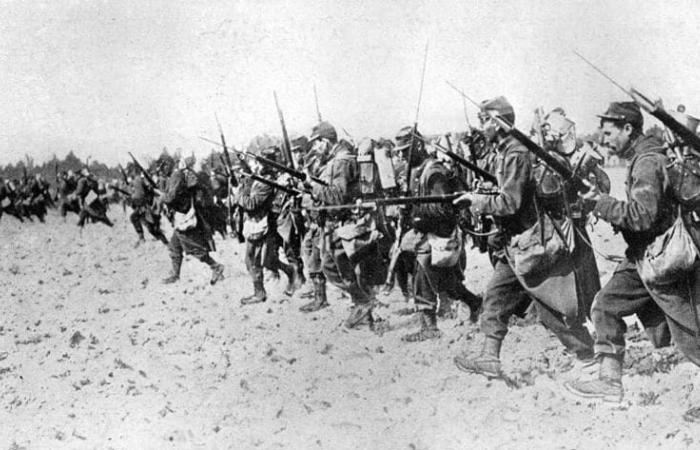
The First World War, often referred to as the “Great War”, but also as European suicide, was a major conflict which profoundly marked the beginning of the 20th century. It extended from July 28, 1914 to November 11, 1918, involving the great world powers and causing political, economic and social repercussions of unprecedented magnitude. On the occasion of the commemoration of November 11, 2024, let us briefly return to the origins, course and consequences of this war which redrew the map of the world and marked Europe.
Origins of the First World War
The origins of the First World War go back to a tangle of political, economic and military, but also family, rivalries between the great European powers. Military alliances, formed in a context of growing tensions, played a key role in the escalation of the conflict. Europe was divided into two main blocs: the Triple Alliance (made up of Germany, Austria-Hungary and Italy) and the Triple Entente (formed by France, Russia and the United Kingdom) . At the head of the main blocs, close or distant members of the same family, who, to caricature a little, preferred to sacrifice their people and lead them to a nameless butchery, rather than settle their affairs as a family.
The trigger was the assassination of Archduke Franz Ferdinand, heir to the Austro-Hungarian throne, in Sarajevo on June 28, 1914, by a Serbian nationalist. This event caused a chain reaction: Austria-Hungary, supported by Germany, declared war on Serbia. Quickly, the game of alliances tipped the whole of Europe into war.
The first phases of the war
At the start of the conflict, many nations expected a short and decisive war. However, Germany’s invasion of neutral Belgium and Britain’s entry into the war transformed the conflict into an all-out war. Germany deployed the plan Schlieffenaiming to quickly defeat France before turning to Russia. But the unexpected resistance of the Franco-British forces, marked by battle of the Marne in September 1914, ended hopes of a quick German victory. The Western Front stabilized, giving rise to trench warfare.
Trench warfare: a struggle of attrition
From late 1914 to 1918, the Western Front stretched from the North Sea to the Swiss borders, characterized by opposing trenches where German and Allied soldiers clashed in inhumane conditions. Life in the trenches was marked by mud, cold, hunger and the constant threat of enemy bombardments and assaults. Deadly battles, such as Verdun (1916) and the Somme (1916), symbolized the horror of this war of attrition. At Verdun, one of the longest and most devastating battles, nearly 700,000 soldiers were killed, wounded or missing in ten months.
The war was not limited to European theaters alone. It took on a global dimension with the involvement of colonies and powers outside Europe. Troops from French, British and German colonies were deployed on the European fronts, providing crucial support. The conflict also spread to the Middle East, Africa and Asia. There Gallipoli campaign (1915-1916) led by the Allied forces against the Ottoman Empire is a striking example of the fighting which took place outside the European continent.
The entry into war of UNITED STATES in April 1917 was a major turning point. Due to Germany’s all-out submarine warfare, which indiscriminately attacked military and merchant ships, President Woodrow Wilson decided to enlist his country on the side of the Triple Entente. The arrival of hundreds of thousands of American troops and logistical support considerably strengthened the Allied forces.
Military innovations and new technologies
The First World War was a laboratory for military innovations. The use of machine guns, tanks (first appearance in 1916 during the Battle of the Somme), and poison gas (used for the first time on a large scale at Ypres in 1915) profoundly changed combat tactics. Military aviation also made its debut, although initially limited to reconnaissance missions. THE airships and the light bombers were used to sow terror beyond the front lines, particularly during raids on British towns.
German submarines, the famous U-Booteposed a formidable threat to Allied shipping, jeopardizing transatlantic supply lines and contributing to the entry of the United States into the conflict.
The decisive year of 1918 and the end of the conflict
The year 1918 was marked by a series of decisive offensives. L’spring offensivelaunched by Germany under the leadership of General Ludendorff, managed to make significant progress on the Western Front. However, the allied forces, reinforced by the arrival of American troops and better organized under the sole command of Marshal Fochlaunched a successful counter-offensive, known as the Second Battle of the Marne.
The German forces, exhausted and demoralized, could not resist this Allied push. Inside Germany, social unrest and revolts broke out, increasing pressure to end the war. On November 9, 1918, Emperor William II abdicated and the Republic was proclaimed. Two days later, the November 11, 1918the armistice was signed at Compiègne, officially ending the fighting.
Human and material toll
The First World War caused more than 18 million dead (military and civilian) and approximately 23 million injured. The human losses were particularly heavy for countries like France, which deplored the loss of nearly 1.4 million soldiers, and Germany, whose losses amounted to more than 2 million soldiers. Precarious living conditions, disease and famine further worsened the human toll.
The economic cost was just as devastating. Europe, once the center of world power, emerged weakened and heavily in debt, marking the end of its economic domination. The material destruction was massive, particularly in France and Belgium, where regions close to the front were destroyed.
Political and geopolitical consequences
The treaty of Versaillessigned on June 28, 1919, ratified the end of the war, but its harsh clauses, particularly towards Germany, sowed the seeds of resentment and indirectly contributed to the emergence of Nazism and the Second World War. The Austro-Hungarian Empire and the Ottoman Empire collapsed, giving rise to new nation-states in Central Europe and the Middle East.
The League of Nations (League of Nations) was created in the hope of preventing future conflicts, but it lacked the ability to enforce its resolutions, particularly due to the absence of the United States.
Today, the First World War is remembered as a tragedy that transformed the world. In France as elsewhere in Europe, the November 11th has become a day of national remembrance, honoring the millions of fallen soldiers. On this November 11, 2024, more than a century after the end of hostilities, it is essential to remember the bravery and sacrifices made by so many men and women, but also to reflect on the lessons that Europeans have learned (or not) of this devastating conflict, which saw European elites knowingly cause millions of their compatriots to die…for nothing, or really not much.
General works on the First World War
- Jean-Jacques Becker, Serge Berstein – History of the Great War: 1914-1918 (Fayard)
- Antoine Prost – The Great War explained to my grandson (Threshold)
- Jean-Yves Le Naour – The First World War: From the assassination of Archduke Franz Ferdinand to the League of Nations (Perrin)
- Pierre Miquel – The Great War (Fayard)
- Stéphane Audoin-Rouzeau, Annette Becker – 14-18: Finding war again (Gallimard)
Strategic and military studies
- François Cochet – The Great War: End of a world, beginning of a century (Tallandier)
- David Stevenson – 1914-1918: History of the First World War (Payot)
- Georges Blond – The Agony of Peace, 1914 (Grasset)
- Hew Strachan – The First World War (Tempus)
- Ferdinand Foch – Memoirs to serve in the history of the war of 1914-1918 (Hachette)
Testimonies and personal journals
- Ernst Younger – Steel Storms (Gallimard)
- Maurice Genevoix – Those of 14 (Flammarion)
- Gabriel Chevallier – Fear (The Pocket Book)
- Roland Dorgeles – Wooden crosses (Albin Michel)
- Henry Barbusse – The Fire (Folio)
Social and cultural aspects of the war
- Stéphane Audoin-Rouzeau – Fighting: A historical anthropology of modern warfare (19th-21st centuries) (Threshold)
- Annette Becker – The Red Scars 14-18: Occupied France and Belgium (Fayard)
- Nicolas Offenstadt – The Shots of the Great War and collective memory (1914-1999) (Odile Jacob)
- Rémy Cazals, Frédéric Rousseau – The Great Civil War: 1914-1918 (Private)
- Jean-Pierre Gueno, Jerome Pecnard – Words of Poilus: Letters and notebooks from the front 1914-1918 (Librio)
Political and geopolitical analyzes
- Georges-Henri Soutou – The Great Illusion: When France Loses Peace, 1914-1920 (Tallandier)
- Christopher Clark – The Sleepwalkers: Summer 1914: How Europe marched towards war (Flammarion)
- John Keegan – The First World War (Perrin)
- Marc Ferro – The Great War 1914-1918 (Gallimard)
- Jean-Baptiste Duroselle – The Great French War 1914-1918 (Perrin)
Specific thematic works
- Jean-Yves Le Naour – The Invention of the Front: 1914-1918, the modernity of the Great War (Threshold)
- Michel Goya – Under fire: Death as a working hypothesis (Tallandier)
- Michel Bernard – The Forests of Ravel (The Round Table)
- Jean-Noël Grandhomme – Verdun 1916: The Battle of France (Perrin)
- Xavier Boniface – The religion of the trenches: Priests and the Great War (Editions du Cerf)
Literature and artistic works inspired by war
- Erich Maria Note – In the West, nothing new (Stock)
- Jules Romans – Men of good will (Gallimard)
- Francois Mauriac – The Leper’s Kiss (Grasset)
- Joseph Kessel – The Crew (Folio)
Additional resources and summary works
- Michel Winock – France and the French during the First World War (Threshold)
- André Loez – 1914-1918: The refusals of war, a history of the mutineers (Gallimard)
- Lucie Aubrac – They will leave drunkenly (The Pocket Book)
- Olivier Forcade, Philippe Vial, Rémy Porte – The Great War: Strategies and assessments (PUF)
- Jean-Claude Delhez – The First World War in 100 questions (Tallandier)
Photo d’illustration : wikipedia (cc)
[cc] Breizh-info.com2024, dispatches free to copy and distribute subject to mention and link to the original source





